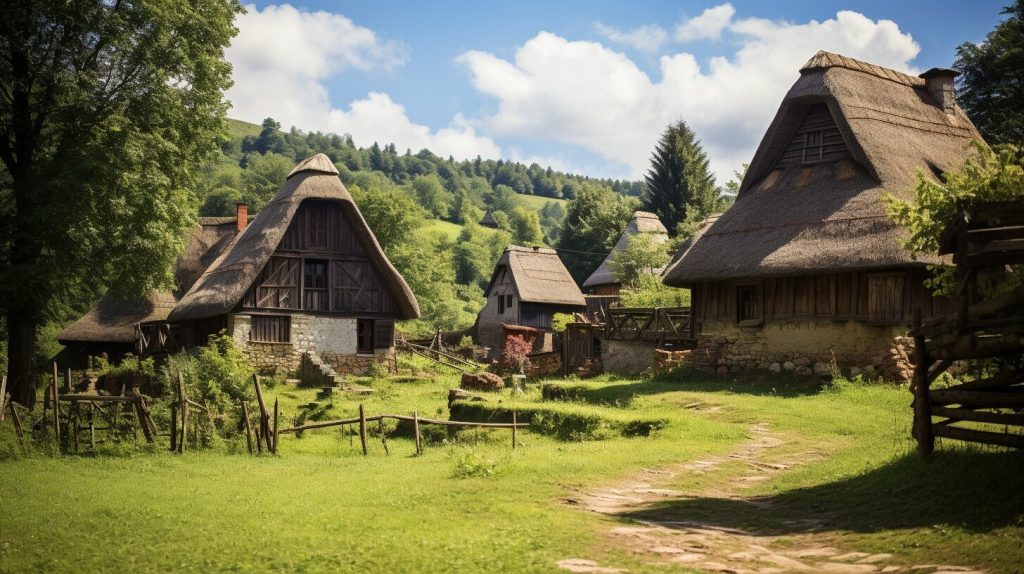
The Village Museum “Dimitrie Gusti” in Bucharest, Romania is a must-visit destination for anyone interested in exploring the history and culture of rural Romania. This open-air museum showcases over 300 buildings that represent the traditional architecture and way of life throughout Romanian history. Visitors can explore the reconstructed rooms and immerse themselves in the rural lifestyle of historic Romania.
The Village Museum has received positive reviews from visitors who appreciate the opportunity to learn about Romania’s rural history and culture. However, some have reported negative experiences with closed houses and a lack of signage. Despite these challenges, the Village Museum remains one of the main tourist attractions in Bucharest.
Key Takeaways:
- The Village Museum “Dimitrie Gusti” in Bucharest is an open-air museum that showcases over 300 buildings from different regions and time periods.
- Visitors can explore the reconstructed rooms to learn about the traditional way of life in historic Romania.
- The museum has received positive reviews, but some visitors have reported negative experiences with closed houses and a lack of signage.
- The Village Museum remains one of the main tourist attractions in Bucharest.
Explore Romania’s Rural History and Culture
The museum at the Village Museum in Bucharest provides a unique opportunity to explore the history and culture of rural Romania. The outdoor museum showcases over 300 buildings representing the history of Romania’s rural architecture, including authentic farmsteads, barns, rural homes, churches, and watermills from the 15th to the 19th century. Visitors can immerse themselves in the traditional way of life in Romania’s various ethnographic regions, including Transylvania, Maramures, Oltenia, Moldova, Dobrogea, Muntenia, and Banat.
The museum’s permanent exhibition includes 123 distinct settlements and over 50,000 objects, such as kitchen utensils, wool rugs, pottery, and farming tools. It is a unique opportunity to experience the folklore and culture of rural Romania. Visitors can learn about the daily lives and customs of the Romanian peasant, including information about traditional clothing, weaving, and customs. The reconstructed rooms within the buildings provide a glimpse into the art, music, and literature of Romania’s rural communities.
For those interested in the village life of Romania, the museum offers a chance to explore the architecture and cultural artifacts that make up Romania’s history. It is a fascinating destination for a glimpse into the rural communities that shaped Romania’s culture and traditions.
[affiliate_offers_block city=”Bucharest” label=”Village Museum, Bucharest” place=”Village Museum”]
Mixed Reviews and Challenges
While the Village Museum has received rave reviews for its extensive collection of rural architecture and artifacts, some visitors have expressed disappointment with various aspects of the museum. One common complaint is the closure of many houses, which limits visitors’ access to the interiors and hampers the museum’s purpose of showcasing the lifestyle of Romanian peasants. Lack of proper signage is another issue, as visitors can find it difficult to navigate the sprawling open-air museum.
Preserving the collection is also a significant challenge at the Bucharest Village Museum, given the perishable materials used in the buildings. The museum staff must continuously monitor and maintain these structures to prevent deterioration and ensure they stand the test of time. Unfortunately, this can result in some houses being closed off to visitors, further adding to their disappointment.
Some visitors have also criticized the lack of facilities and the rudeness of the museum staff. While the museum is undoubtedly an essential and popular tourist attraction, it must continuously work to address these challenges and improve the visitor experience.
The History and Founding of the Museum
The Village Museum in Bucharest was founded in 1936 by sociology professor Dimitrie Gusti, who conducted years of field research to create the museum’s collection. Gusti and his team of researchers traveled throughout Romania, documenting the architecture, traditional crafts, and way of life of the rural population. The aim was to preserve Romania’s cultural heritage and create a permanent exhibition that would showcase the country’s rural history and culture for future generations to appreciate.
Gusti’s vision for the museum was to showcase the real-life of the Romanian village, which was different from the romanticized images created by artists and writers. To achieve this, Gusti’s team would often take over homes in rural communities, bringing in the former homeowners, along with their livestock and birds, to create an authentic experience for visitors.
Initially, the museum started with a few buildings, but it soon grew to occupy almost 25 acres of land, with 272 authentic peasant homes, farms, barns, churches, and more. The museum offers a remarkable insight into the rural life of the Romanian people, with structures dating from the 15th to the 19th century, representing various regions and different stages of Romania’s history.
The museum faced tough times during World War II and the Communist regime, but has been restored with the help of grants and is now one of the most captivating outdoor ethnographic museums in the world. Visitors can explore the museum’s exhibits and learn about traditional crafts, folklore, and the daily life of the Romanian countryside. Today, the Village Museum stands as a testament to Gusti’s vision and his tireless dedication to preserving Romania’s cultural heritage.
A Closer Look at the Museum’s Collection
The Village Museum in Bucharest features a collection of authentic buildings representing different regions and time periods of Romania. Founded in 1936 by sociologist Dimitrie Gusti, the open-air museum showcases rural Romanian culture and architecture with over 270 farms, peasant homes, barns, and a wooden church. The museum’s collection includes a diverse range of traditional dwellings made from wood, clay, straw, and stone, which provide a glimpse into the daily life of Romanian peasants from the 15th to the 19th century.
Visitors can explore the museum’s reconstructed rooms and discover the tools and utensils used in the daily life of the Romanian peasants. Various artifacts such as wool rugs, pottery, and farming tools are on display, including metal crafts made by the local Gypsy population of Romania.
With its extensive collection of cultural artifacts, the museum represents the unique identity of Romanian peasants and their history. Visitors can discover the different regions of Romania represented in the museum, including the Moldavia, Oltenia, and Transylvania regions. The buildings in the museum are authentic, and their architecture mirrors the countryside of Romania.
Take a guided tour or explore the museum at your own pace with an audio guide. Visitors can immerse themselves in the rural Romanian culture and take a step back in time by visiting the museum. The on-site restaurant offers a chance to taste authentic Romanian dishes.
Whether you visit during the lively summer or the serene winter, the Village Museum in Bucharest offers an enchanting experience for those interested in Romanian folklore and heritage. The museum is a must-visit destination for anyone interested in the diverse architecture and cultural artifacts of Romania.
Plan Your Visit to the Village Museum in Bucharest
To reach the Village Museum in Bucharest, visitors can take advantage of guided tours, sample traditional Romanian dishes, and use various transportation options. This outdoor museum offers a unique opportunity to step back in time and learn about Romania’s rural history and culture.
The museum is open year-round, and visitors can choose between a guided tour or a self-guided tour. Guided tours are available in multiple languages and require a reservation. Alternatively, visitors can rent audio guides or use a smartphone app for a self-guided tour. The museum provides signage in both English and Romanian, making it easy to navigate the grounds.
While exploring the museum, visitors can also enjoy traditional Romanian cuisine. There are kiosks and tables selling homemade goods, such as sweets, cakes, pies, and delicious bread. Additionally, there are eateries in the area, including a restaurant called Calle La Francu, which serves authentic Romanian dishes.
To get to the Village Museum, visitors can take a bus or the metro from the city center. Alternatively, taxis are readily available and affordable in Bucharest. For a complete overview of what the city has to offer, don’t miss our all-inclusive travel guide on Romania’s capital.
A visit to the Village Museum is a must for anyone interested in experiencing the folklore and traditional life of the Romanian countryside. It offers a unique glimpse into rural Romania’s history, culture, and architecture, making it one of the best things to do in Bucharest.
In Conclusion: A Unique Opportunity to Explore Rural Romania
In conclusion, the Village Museum “Dimitrie Gusti” in Bucharest, Romania offers visitors a unique opportunity to explore the history and culture of rural Romania through its extensive collection of authentic buildings and cultural artifacts. Established in 1936 by sociology professor Dimitrie Gusti, the museum provides an immersive experience, allowing visitors to step back in time and learn about Romanian folklore and traditions.
The museum’s collection includes a variety of authentic buildings such as houses, barns, farmsteads, and churches from different regions of the country, providing a diverse representation of Romania’s rural architecture throughout history. Visitors can explore reconstructed rooms within the buildings, giving them a glimpse into the daily lives of the Romanian peasant.
Despite facing challenges over the years, including the closure of houses and lack of amenities, the museum has been restored and expanded into one of the most captivating outdoor ethnographic museums in the world. The museum’s collection is composed of perishable materials, which presents a challenge in preserving the collection. However, the museum’s staff remains committed to maintaining and protecting this important piece of Romania’s cultural heritage.
Visitors to the Village Museum can choose between guided tours or self-guided exploration, and there are also options for food and souvenir shopping on the museum grounds. The museum offers a unique glimpse into Romania’s cultural heritage, and it is a must-visit destination for anyone interested in experiencing the traditional rural life of Romania.
Plan Your Visit to the Village Museum in Bucharest
If you’re interested in visiting the Village Museum “Dimitrie Gusti” in Bucharest, you can easily plan your visit. The museum is located in the Herastrau Park and is open all year round. Transportation options include public transportation, taxis, or car rentals. Guided tours are available in multiple languages, including English, and visitors can enjoy traditional dishes in the museum’s restaurant.
FAQ
Q: What is the Village Museum “Dimitrie Gusti”?
A: The Village Museum “Dimitrie Gusti” is an open-air exhibition in Bucharest, Romania that showcases over 300 buildings representing the country’s rural architecture throughout history.
Q: What are some positive reviews of the museum?
A: Visitors have praised the museum for its immersive experience, the opportunity to see reconstructed rooms within the buildings, and the chance to explore and learn about Romanian village life.
Q: What are some negative reviews of the museum?
A: Some visitors have mentioned that many of the houses were closed during their visit, preventing them from seeing the interior and fully understanding the history of Romanian village life. Others felt that the museum lacked proper signage and amenities such as restrooms.
Q: Who founded the Village Museum?
A: The Village Museum was founded in 1936 by sociology professor Dimitrie Gusti.
Q: What is the museum’s mission?
A: The museum’s mission is to present the real life of the village and the culture of the Romanian peasants.
Q: How can I reach the Village Museum?
A: Visitors can take a bus or the metro from the city center. Taxis are also a convenient means of transportation in Bucharest.
Q: What are some highlights of the museum’s collection?
A: Some highlights include a wooden Maramureş church with beautiful faded icons and houses showcasing the metal crafts of the Gypsy population.
Source Links
- https://www.tripadvisor.com/Attraction_Review-g294458-d318261-Reviews-Muzeul_National_al_Satului_Dimitrie_Gusti-Bucharest.html
- https://muzeul-satului.ro/en/
- https://muzeul-satului.ro/en/acces-muzeu/bilete/
- https://muzeul-satului.ro/en/despre-noi/istoric-muzeul-satului/
- https://comminfo.rutgers.edu/news/alise-honors-dissertation-exploring-vernacular-museums-romania
